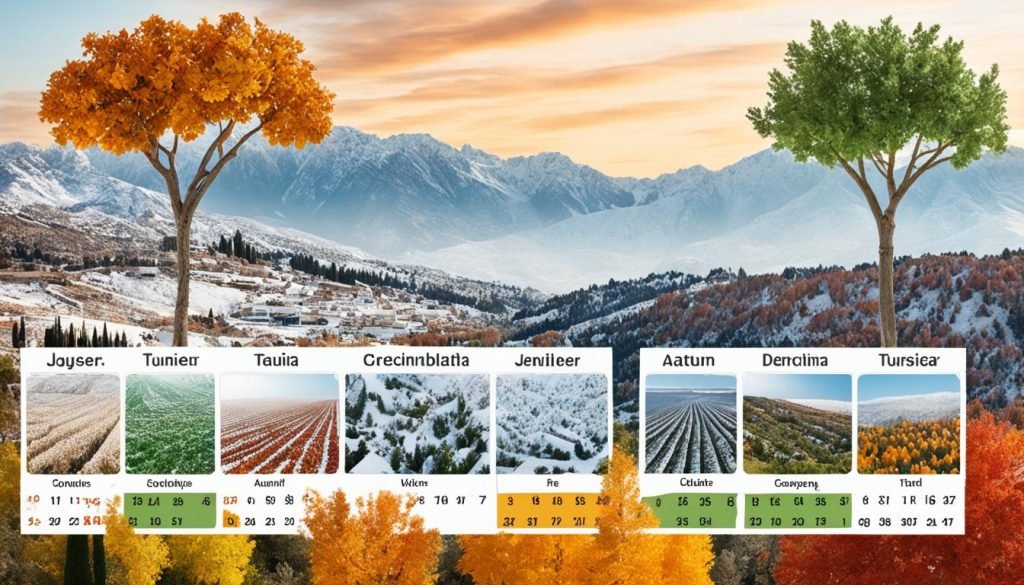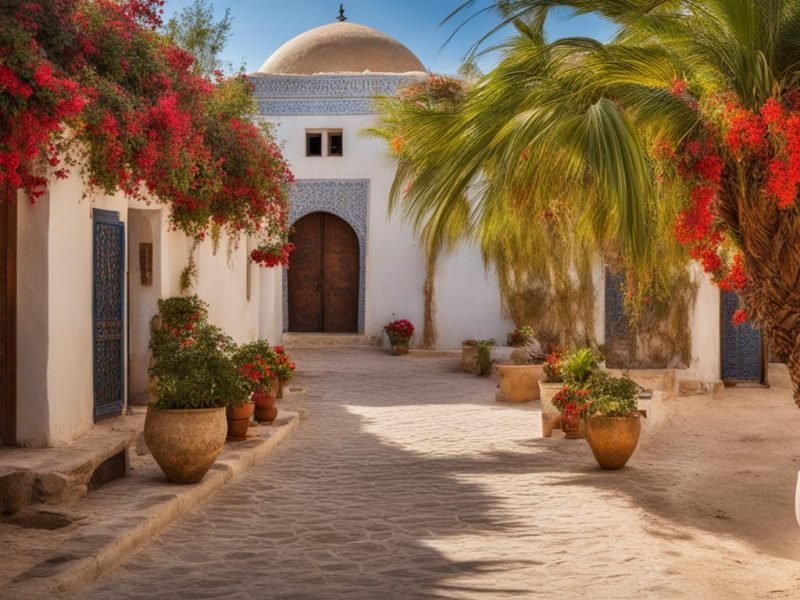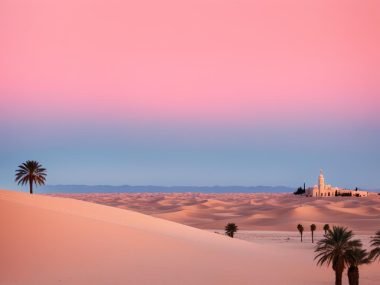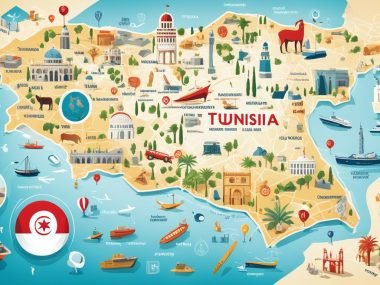Did you know Tunisia is really special in its weather? It has different climates from north to south. Because of this, when the season starts in Tunisia depends on your location.
In the north, it feels more like the Mediterranean. It has cool, wet winters and warm, dry summers. In the south places like Douz and Tozeur are always hot and dry. Knowing about Tunisia’s different seasons helps pick the best time to visit. It helps avoid lots of tourists too. The best time to go is spring (April and May) or autumn (October and early November). That’s when the weather is nicest and there are fewer people around.
Key Takeaways
- Seasonal transitions in Tunisia vary significantly between the north and south.
- Northern Tunisia experiences Mediterranean climates with distinct seasons.
- Southern Tunisia maintains a consistently hot, dry climate due to its desert geography.
- The optimal Tunisia travel season is in spring and autumn, offering milder temperatures and fewer crowds.
- Understanding regional differences is key to planning your travel to Tunisia.
Overview of Tunisia’s Climate
Tunisia’s weather changes a lot from north to south. This means you get different weather depending on where you are. In the north, it feels more like the Mediterranean. Down south, it’s hotter, like in a desert.
North vs South: A Tale of Two Climates
In the north, winters are mild and it rains. Summers are hot but dry. Temperatures go from about 10°C in winter to 27°C in summer. The south is warmer, especially in summer. Here, it gets up to 32°C.
Average Temperatures Throughout the Year
Temperatures in Tunisia change a lot during the year. This table shows the average temperatures. It helps people plan their days and activities.
| Month | North (°C) | South (°C) |
|---|---|---|
| January | 10 | 11 |
| April | 15 | 22 |
| July | 26 | 31 |
| October | 21 | 26 |
Rainfall Patterns in Tunisia
In the north, it rains a lot. This is why it’s so green and good for farming. But the south is much drier, getting very little rain. This shows how different the weather can be in Tunisia.
January and February: Winter Months
January and February in Tunisia are unique. The country offers a special winter experience then. These months have different weather, making it great to see Tunisia’s north and south.
Winter Activities in Northern Tunisia
It’s mild in the day but cold at night in North Tunisia. Temperatures are between 8°C to 17°C. This is perfect for outdoor fun without the hot summer sun.
You can visit cultural spots, historic landmarks, or walk in beautiful towns. Places like Carthage, Tunis Medina, and Dougga are best visited now. The cool weather helps a lot.
Exploring the South During Winter
On the other hand, South Tunisia is warmer. It invites you to see the Sahara’s beauty. January and February are warmer here than in the north. It makes desert exploring comfy.
You can visit oases, go on camel rides, or enjoy Douz and Tozeur’s unique festivals. These winter months make these activities special.
March to May: Embracing Spring
Spring in Tunisia means comfort and beauty. It’s ideal for travel from March. Temperatures go up from 16°C to 20°C, starting the Tunisia tourist season. Days get longer, and there’s less rain. This makes it great for being outdoors and exploring culture.

Spring Weather Patterns
The weather is mild in spring, with less rain and blossoming scenery. March sees temperatures of 16°C to 20°C. By May, it’s warmer, between 20°C and 25°C. This warm weather invites visitors to see Tunisia’s beauty.
Key Events and Festivals
In spring, you can experience events like Ramadan and Eid al-Fitr. These offer a peek into local traditions and celebrations. There are also flower and food festivals, celebrating Tunisia’s heritage.
Best Outdoor Activities
Spring is perfect for outdoor fun. Pleasant weather and blooming flowers are ideal for hikes. The Atlas Mountains and Zaghouan trails are good places to start. Visiting ancient sites like Carthage and El Djem is also a must. Plus, apricot trees bloom, making the countryside even prettier.
Here’s a quick look at the spring months:
| Month | Average Temperature (°C) | Key Features |
|---|---|---|
| March | 16-20 | Start of Tunisia tourist season, reduced rainfall |
| April | 18-22 | Blooming landscapes, hiking and tours |
| May | 20-25 | Apricot trees blossom, cultural events and festivals |
June to August: Summer Heat
Summer in Tunisia means lots of sun, perfect for beach lovers and water sports fans. The hottest months are July and August, with temperatures often going over 30°C. Let’s explore some fun activities and essential safety advice for this hot season.
Summer Activities and Attractions
Places like Hammamet and Sousse get really busy during summer in Tunisia. You can swim, jet ski, and parasail there. If you love history, visit the ancient ruins of Carthage or the Medina of Sousse. When it cools down at night, check out the markets or walk on the beach.
Safety Tips for Travelling During Peak Heat
Here are some tips to stay safe in Tunisia’s summer:
- Hydration: Drink lots of water often, even if not thirsty.
- Sun Protection: Use sun cream with high SPF, wear sunglasses and a wide hat.
- Avoid Peak Hours: Stay inside or in the shade when it’s hottest, from 11 a.m. to 3 p.m.
- Light Clothing: Wear loose, light clothes to stay cool.
- Monitor Health: Watch for heat exhaustion signs like dizziness and get to a cool place if needed.
Follow these tips for a great time during summer in Tunisia.
September to November: Autumn Arrives
As summer ends, autumn in Tunisia brings cooler, lovely weather. From September to November, it’s cooler and nice outside. The temperatures are between 20°C and 25°C. This makes it a great time to see Tunisia’s beauty without the summer heat.
Weather Transition in Autumn
In autumn, the weather slowly changes. Places near the sea like Tunis and Sousse have warm days but cool nights. This makes autumn a good time to travel. Inland, like Kairouan, the weather is also great for visits to historical places.
Harvest Season Highlights
Autumn is important for farming in Tunisia. It’s when dates and olives are picked. People can join in on the harvest. This gives travellers a real taste of life in the countryside. They take home special memories of Tunisia.
| Month | Average Temperature (°C) | Activities | Events |
|---|---|---|---|
| September | 25°C | Beach Visits, Hiking | Harvest Festivals |
| October | 22°C | Cultural Tours, Archaeological Site Visits | Olive Harvesting |
| November | 20°C | Cooking Classes, Vineyard Tours | Autumn Markets |
Autumn in Tunisia is full of senses. There’s the light on old ruins and the smell of fresh olives. The weather is just right for enjoying this place’s warm welcome and beautiful sights.
December: Transition into Winter
December marks the start of winter in Tunisia, as shown by the Tunisia seasonal calendar. Days stay quite warm, but nights get much colder. Remember to pack for cool breezes, especially by the sea.
Visiting in December means fewer tourists. This makes seeing Tunisia’s wonders more personal. Night skies are clear, perfect for stargazing along the coast.

The end of the year brings a festive mood to Tunisia. Markets and parties are full of life. You get to try local foods and join in the fun.
The Tunisia seasonal calendar shows that it rains more in December. But, warm days and cool nights make it nice to explore everywhere.
Tourist Seasons in Tunisia
Tunisia has busy and quiet tourist seasons. Knowing these can help you plan better. Each season offers different experiences.
High and Low Tourism Months
The busiest months are July and August. They bring lots of visitors to the beaches and sites. But January, February, June, November, and December are quieter. You’ll find fewer people around then.
When to Avoid Crowds
March to May and September to October are great for fewer crowds. The weather is nice, and it’s less busy. Remember to check for local holidays and school breaks. They can affect how crowded it is.
Best Time to Visit Tunisia
Tunisia offers something special every season. From the Mediterranean coast to the Sahara Desert, knowing When Does The Season Start In Tunisia helps plan your visit.
Optimal Months for a Visit
Spring and autumn are great times to visit Tunisia. May and October are best. The weather is mild, and there is less rain. You can enjoy both the mountains and the sea.
Weather Advantages by Season
Tunisia is great any time of the year, based on what you like:
-
Spring (March – May): You can enjoy being outdoors and seeing historic sites.
-
Summer (June – August): Perfect for those who love the beach. It’s a bit cooler by the sea.
-
Autumn (September – November): The weather is nice for both relaxing and going on adventures.
-
Winter (December – February): A great time to see the south, especially the Sahara, as it’s cooler.
| Season | Advantages |
|---|---|
| Spring | Ideal for outdoor activities and cultural excursions |
| Summer | Perfect for beach holidays along the Mediterranean |
| Autumn | Pleasant weather for both relaxation and exploration |
| Winter | Great for exploring the Sahara Desert |
Knowing When Does The Season Start In Tunisia and the climate helps make your visit great. Tunisia offers a lot every season.
Month-by-Month Guide to Tunisia’s Seasons
Tunisian weather changes from winter’s chill to summer’s warmth. Knowing the weather by month makes your trip perfect. You’ll match your plans to what each season offers. This guide talks about Tunisia’s varied climates.
January through March
The weather is cool from January to March, with more rain up north. January and February feel wintry but different from usual Mediterranean spots. The south is warmer, great for visiting when fewer people do.
April through June
Spring brings warmer days good for being outside. There’s lots of flowers, so it’s great for walks and seeing places. The weather balances sunny days and cool nights well. You can enjoy the coast or the desert.
July through September
Summer is really hot, often over 30°C. It’s the best time for those who love the beach. Places like Sousse and Hammamet get busy with water sports and sunbathing. Remember to drink water and stay in the shade.
October through December
Autumn cools down, nice for outdoor fun. It’s time for harvest festivals, offering unique cultural moments. December gets cooler, leading to a calm end of the year. It’s a good time for easy-going trips.
Source Links
- https://seasonsyear.com/Tunisia – Seasons in Tunisia: Weather and Climate
- https://www.responsibletravel.com/holidays/tunisia/travel-guide/best-time-to-visit – Best time to visit Tunisia
- https://wildyness.com/news/best-time-visit-tunisia – Best Time To Visit Tunisia – A Climate Guide Included







